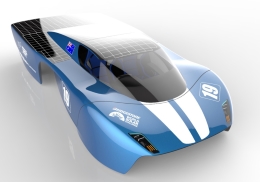16 May 2019
 When the 2019 Bridgestone World Solar Challenge rolls through central Australia in October, it won’t only put some of the world’s most advanced sun powered cars through their paces, it will also road test a new energy management system developed by the University of South Australia.
When the 2019 Bridgestone World Solar Challenge rolls through central Australia in October, it won’t only put some of the world’s most advanced sun powered cars through their paces, it will also road test a new energy management system developed by the University of South Australia.
UniSA PhD student Erika Belchamber has developed an energy management strategy that maximises efficiency in balancing solar input, battery storage potential and energy output, and her technique has massive potential beyond October’s event.
“In the race, the system ensures we travel the maximum distance each day with the available amount of light, getting the greatest efficiency from the solar energy,” Belchamber says.
“But equally, you can think of a house with solar panels and a battery as a solar car without wheels, so everything we explore through the race will be applicable for renewable energy use in the wider world.”
The system has already attracted interest from the energy industry, offering the potential to maximise the value of variable renewable inputs, such as wind and solar, as part of a mixed source electrical feed.
“The system uses rapid input predictions based on the best and worst possible scenarios for generation, and then decides the best balance between storage and output,” Belchamber says.
“In commercial applications, by combining this with energy tariff information and availability from different sources, you could tailor the efficiency of the system in different ways, such as to be the most cost-effective for the end user, or to use the most renewables possible.”
The system will feature in the Bridgestone World Solar Challenge on a cruiser class solar car developed by a team from the Australian Technology Network of Universities (ATN), a collective including UniSA, Queensland University of Technology, University of Technology Sydney, RMIT University, and Curtin University.
The cruiser class category features cars as close to a conventional sedan as possible, and in addition to developing the solar technology and energy management system, UniSA has been project manager on the development of the team’s vehicle.
Team leader Professor Peter Majewski says there is a real sense of excitement and anticipation about the event, which has been boosted by the collaborative nature of the ATN project.
“It has been fantastic to see how all these different ideas have come together in creating this vehicle,” Prof Majewski says.
“It has been a real collaboration, with each university adding its own expertise, and the result is, I believe, more than the sum of its parts, with the sharing of ideas driving innovation in the design.”
With all elements of that design now finalised, the car is currently in the final phases of production at RMIT in Melbourne, with road testing due to begin in June.
“We are all very excited to get it on the road,” Prof Majewski says. “I think the end result is something we can all be proud of.”
The 2019 Bridgestone World Solar Challenge kicks off in Darwin on 13 October, and travels through central Australia, before finishing in Adelaide a week later.
………………………………………………………………………………………………………………………
Media: Dan Lander office (08) 8302 0578 | mobile:0408 882 809 | email: dan.lander@unisa.edu.au



